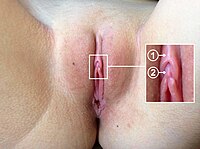
Photo from wikipedia
It has been recognized for some time that females appear to be overrepresented in the incidence of many vestibular disorders, and recent epidemiological studies further support this idea. While it… Click to show full abstract
It has been recognized for some time that females appear to be overrepresented in the incidence of many vestibular disorders, and recent epidemiological studies further support this idea. While it is possible that this is due to a reporting bias, another possibility is that there are actual differences in the incidence of vestibular dysfunction between males and females. If this is true, it could be due to a sexual dimorphism in vestibular function and therefore dysfunction, possibly related to the hormonal differences between females and males, although the higher incidence of vestibular dysfunction in females appears to last long after menopause. Many other neurochemical differences exist between males and females, however, that could be implicated in sexual dimorphism. This review critically explores the possibility of sexual dimorphism in vestibular function and dysfunction, and the implications it may have for the treatment of vestibular disorders.
Journal Title: Journal of neurophysiology
Year Published: 2019
Link to full text (if available)
Share on Social Media: Sign Up to like & get
recommendations!